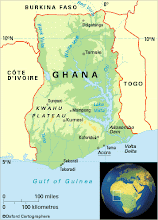Ghana’s Roads
The journey from Accra to Cape Coast was our first real experience of Ghanaian roads and Accra’s horrendous traffic. It probably took nearly two hours to get out of the capital and onto the main Cape Coast road. Some of the traffic jams are caused by road works taking place to widen and improve the main highways.
Road safety, or rather the lack of it, is a major concern. Cars often travel very fast and overtake in dangerous places despite road markings prohibiting such manoeuvres.
In an attempt to improve the situation, there is an on-going campaign to raise awareness of the dangers. Most main roads also have traffic police check points where some of these hazards are addressed. However, a number of Ghanaians have suggested that some police officers would be prepared to accept money to turn a blind eye.
We are fortunate to have the services of an excellent and very experienced driver. Anyone travelling to Ghana on holiday would be well advised to only travel during the day and ensure that car hire comes with a driver who has experience of dealing with the many challenging road conditions in the country.
The journey to Cape Coast also gave us a glimpse of many people’s living conditions and working lives. It was surprising to see that just a short distance outside the capital city many people living in small communities with buildings constructed in a traditional way with clay walls and roofs made from leaves or thatch. These homes were in stark contrast to the villa we were staying in.
Many people earn a living by trading from roadside and market stalls. A range of new and used goods are sold as well as a wide range of food stuff.
The scenery was very green. There were many small scale pineapple growers selling the delicious and very sweet Cape Coast pineapples by the side of the road.
Kakum National Park
Kakum National Park is just north of Cape Coast in an area of protected rainforest. I overcame my dislike of heights (by not looking down!) to negotiate the seven spans of the canopy walk.
Doris was our expert guide for the nature walk on the floor of the rainforest. She explained about the ways in which the plants of the rainforest are still used in traditional herbal medicine.
Meeting the locals
After leaving Kakum National Park, we stopped at a cafe and met some of the locals – we decided this bench was taken!
Gulf of Guinea
Fishing is how many people earn their living in this part of Ghana. Every evening except Monday many small boats set out to sea for a night’s fishing.
The slave fort at Elmina
As a teacher of History, man’s inhumanity to man throughout the ages, which sadly continues to the present day, has never failed to astound me. No episode of history illustrates this more profoundly than the enslavement of millions of Africans from the 15th to 19th century. The string of slave forts along the West African coastline is a poignant reminder of the suffering that once took place here.






















